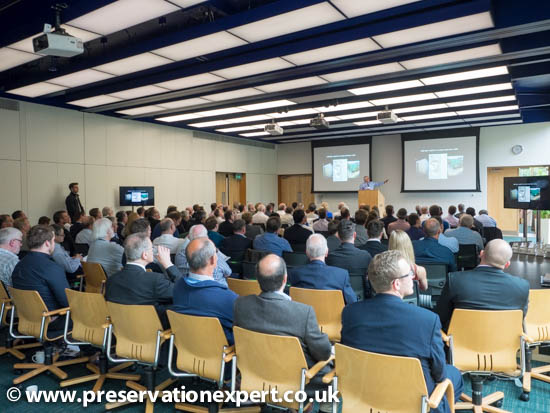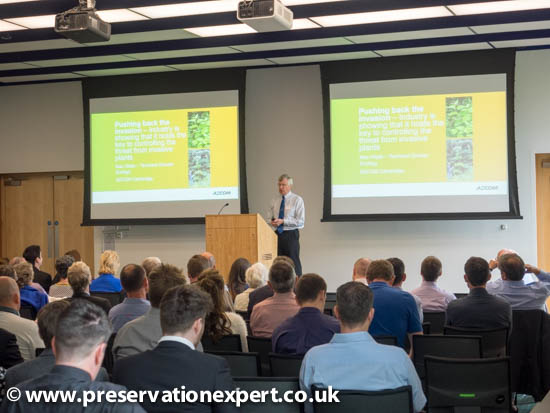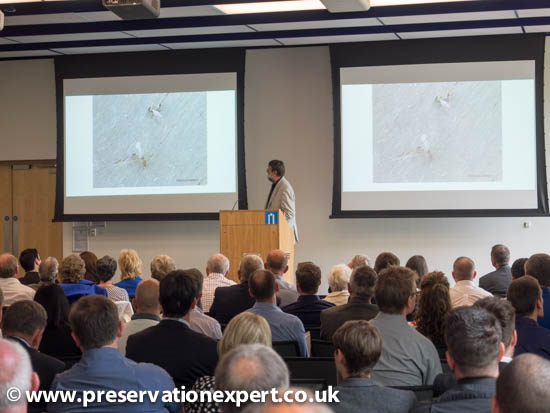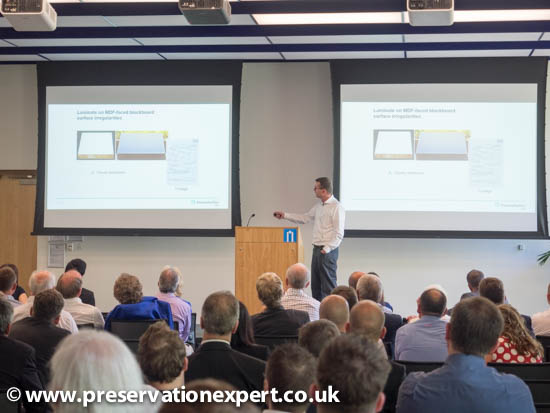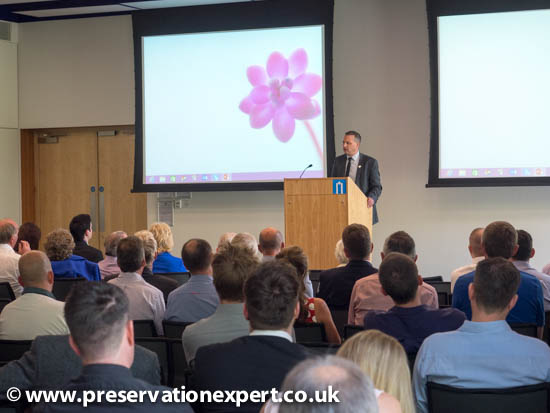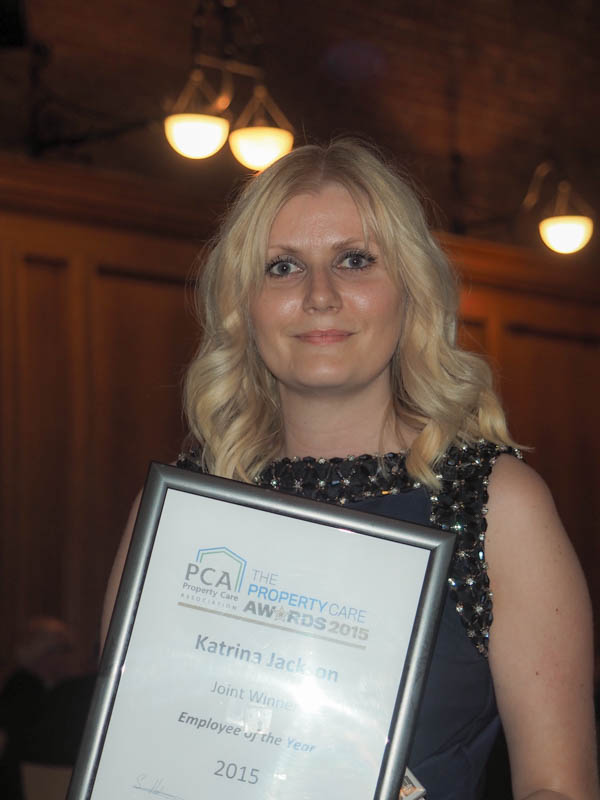I attended the Property Care Association conference last week. It was the best yet, with five speakers on a wide range of relevant preservation topics.
The first was Peter Wilson of The Wood Studio
The wood studio is part of the Forest products section of Edinburgh Napier University.His presentation was excellent, filled with great nuggets of information about the development of timber-based products for use in the built environment. Many of the uses of locally grown softwoods, formed into cross-laminated members were astonishing. I had no idea that quickly grown spruce, considered ‘low grade’ by some, could be fashioned into amazingly strong and quite beautiful buildings.
In fact over 100 long span wood bridges have been built in the UK using low value timber sourced in the UK – the savings on transport and carbon release are incredible, not to mention the commercial benefits for UK growers and consumers. Research by Peter and his team is driving forward timber technology and bringing commercial benefit, as well as providing zero carbon and even carbon positive building project using wood. The strength and flexibility of these new wood applications is tremendous.
He’s a passionate and eloquent ‘wood junky’ for sure and everyone in the conference enjoyed the talk. Some of the images were really breath-taking. I was taken by the Wood Studio’s use of a new acoustic tool, which can measure the strength of timber before installation or in use, just by passing vibrations through it – brilliant!
Professor Max Wade
Max talked about the issue of invasive weeds. This is a real hot potato and the media are getting hold of this and it’s cauing concern for property owners and managing agents too.
The property care association have been proactive in developing a qualification for invasive weed surveyors and technicians and have issued a groundbreaking code of practice on Japanese knotweed treatment. Weeds are not my field, so I didn’t sit through the entire talk, as I wanted to chat to a SPAB technical group member, about repairs of traditional buildings using lime mortars. However, I took a straw-poll of some of the guys who did and they were very impressed and, his advice and information was well received.
Brian Ridout
Brian Ridout is well know in the preservation and conservation industries and came ‘armed’ with a presentation entitled “Remedial Treatment and Heritage Conservation – A clash of approaches”. However, I think he was surprised; the anticipated clash, turned out to be a muted mumble from a tiny minority of those present.
His talk included an illuminating history of the recognition and treatment of Dry Rot, as well as other brown rots. He was able to fill in some grey areas for me and other members, particularly the cultural aspects of rot treatment and how some of the post war ‘over-treatment’ practices came about – I found it fascinating. It was good to sit and listen to someone with such great experience, especially of surveying very old and historic buildings, for rot and timber infestation.
Brian’s presentation was very well received by the vast majority of the conference delegates, most of whom are of course either PCA contractor members or surveyors – I think Brian was pleased and maybe a bit surprised.
I have some thoughts on the above and feel some explanation is needed
There has been friction between some members of the preservation industry and members of the traditional and historic building ‘faction’ in recent years. However, the expected ‘clash’ didn’t happen and I think this explains a lot. Historically there has been little if any dialogue, between PCA members and English Heritage, The society for the protection of ancient buildings (SPAB) or the heritage sector in general. As a result, we find ourselves exposed to each other’s opinions and actions piecemeal and generally, in a negative way; we (some of the preservation sector) may pigeonhole conservationists as luddites, or pampered toffs and they, have us all down as chemical salesmen and vandals of historic fabric.
Of course there’s some truth in both the above stereotypes – there are some rouges out there and there are some luddites – conservation isn’t immune to poor practice or even cowboys – nether is preservation. However, the lack of any real effort to speak to each other and explore each other’s opinions left us with only our differences to reflect on. The bad experiences we have, which are the fault of the ‘other lot’ are all we have to go on, and these events get over-blown and the stories are told and re-told, getting steadily more animated as time passes. Before long these experiences define the ‘other side’ and that is how the stereotypes prosper.
Steve Hodgson (PCA CEO) and Douglas Kent (SPAB technical and research director), have worked hard to change that. We now have a SPAB course within the PCA’s catalog, which is fully subscribed and, the first one was oversubscribed. In each camp there are detractors, who are suspicious and worried about the other. However, talking and learning good practice is never a bad thing. In the case of the preservation industry, the PCA is pre-eminent in promoting best practice. It’s member’s carry out the bulk of preservation work. Successful and progressive members are commercial businesses and this is no bad thing. The skills they have can be applied to any and all buildings – with special attention given to avoiding unnecessary damage to historic fabric – either by inappropriate materials, techniques or treatments, where these are essential. The heritage section will benefit too, because the ‘damage’ they perceive to be caused by the preservation industry will be reduced – at least where PCA members are concerned. It wont be plain sailing of course – that is life. But where there’s efforts to learn from each other, respect will grow and this must benefit the housing stock in my view.
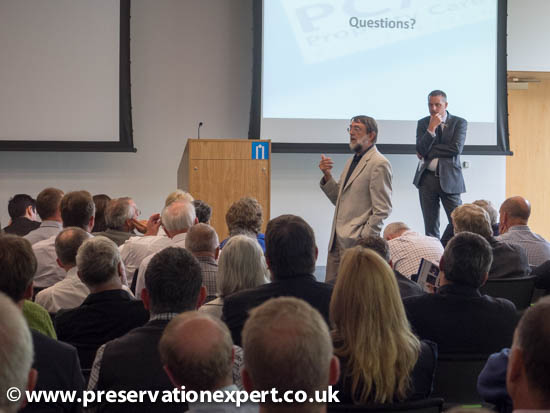
Brian takes to the floor to field questions from PCA members – more of a meeting of minds than a ‘clash’. A success!
This is why the ‘clash’ didn’t happen and the delegates applauded Brian
I took another straw-poll on the question of mass-irrigation of masonry for dry rot eradication. I only found one member, who thought that this was justified and the rest just don’t do it at all, or very very rarely (even those few will think twice now, after Brian’s talk).
Brian mentioned that he had trouble finding specialist contractors who would guarantee dry rot, without mass-irrigation…. I found over 20 in less than ten minutes. This shows that Brian’s exposure to bad practice (which is real) may have slightly coloured his opinion of us all. In this respect the PCA membership have a duty, to reach out to the heritage sector and show them that a few bad experiences do not represent our values or methods.
Brian’s preference for promotion of rapid drying, good maintenance of buildings and minimal replacements is already dominant in the membership – we just need to push that, into some of the less adaptable companies. I’d be happy to confidentially help any PCA member look at their Dry Rot treatment schedules, to cope with this change.
Durk Lukowsky’s talk on “ Failure analysis of wood and wood based products”
Dirk works with the Fraunhofer organisation in Austria. He is the author of a superb book on the subject Dirk was entertaining and passionate about his work. His presentation includes a plethora of information on easy to use and economic inspection and testing methods – I’ve already ordered his book and a USB microscope!
Methods like microscopy are already familiar to us, however, his sampling methods and the use of ‘brass rubbing’ to improve the definition of surface undulation anomalies was fascinating and a revelation. He covered his methods, methodology, many examples of failure and details on how to interpret findings.
Steve Hodgson – Property Care Association CEO
Steve closed the conference with an explanation of the exciting career paths now opening up for students and others, to join and strengthen the preservation industry. He and his team have worked hard with CITB to bring together the new Preservation section apprentice scheme. The scheme is now finalised, written by PCA independent member Peter Macdonald. It is awaiting administrative approval for a launch before the end of the year.
There was lots of smiling faces after Steve’s talk, as many members are suffering due to the difficulty of finding good, well-trained staff. Like many members I train my own and it takes years – having a proper apprentice scheme will attract more bright people and will eventually build a pool of good qualified technicians for us all.
Good practice awards
Of course like all conferences there’s an evening do and the PCA awards feature here.
The awards scheme has been going seven years now and highlights the efforts of members in crucial areas such as Training, staff development, innovation, contractor of the year and web site of the year and project of the year. Individuals are rewarded too, student of the year in waterproofing, remedial treatment and Japanese knotweed. There’s also employee of the year, for members to showcase employees who go the extra mile for clients, workmates and businesses.
There was also an extra surprise award this, year for the Egghead or nerd of the year… this was won by my friend Ross Charters of Complete Preservation – a more worthy winner doesn’t exist, as he is enthusiastic, dedicated and a brilliant exponent of the use of science based damp diagnosis methods. He is also a kind and helpful person, who is held in great respect by many of us, so his award was greeted by cheers and applause across the room – well done Ross!
Last year my little firm were nominated Contractor of the year 2014, so we were well prepared to hand over our title to another worthy member (Stonehouse Basements )
Project of the year was won for the third year running by our good mates at Trace Basements. The award for innovation and sustainability went to my old colleague from Brick-Tie Russell Rafton, and his firm DryFix…. Outstanding. However, We were all delighted and honored when our very own general manager, Katrina Jackson was jointly awarded Employee of the Year. Katrina collected an iPad and a bottle of bubbly. We were chuffed too, when new PCA member Paul Walker received a commendation in the employee of the year category. This reflects the PCA’s growth and attraction for new talent and he’s a worthy addition to PCA membership.
Training and Staff development award 2015
I was gobsmacked when Sue Uttridge read out our company name for this award; Training and staff development. We last won this catagory in 2013 and were commended for the same category in 2010 and 2012, so it’s a specialty. However, each year the strength of competition for these awards grows and the quality of the entrants is higher and higher, so frankly I didn’t expected to win at all and was ready to congratulate the firm who would beat us this time. Well respected market leading PCA member preservation company Rentokil were highly commended for their training and staff development efforts, with their graduate training scheme singled out for praise.
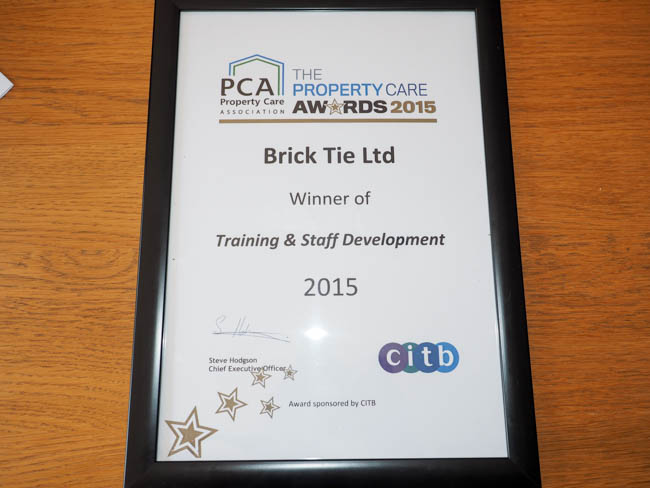
Dry Rot’s own firm (Brick-Tie Limited), win the training and staff development award for the second time in three years.
That’s my take on the Property Care association 2015 conference and AGM. I hope that readers will attend next year as it gets better and better and is well worth making in space in the diary for.
Dry Rot.
